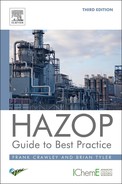The Guideword-First Approach to HAZOP
Abstract
Flow diagram for the guideword-first approach to HAZOP study and an explanation of the differences from the parameter-first approach outlined in Chapter 4.
Keywords
Guideword-first approach
In Chapter 4, a detailed description is given of the parameter-first approach to HAZOP study, perhaps the most widely used approach particularly for continuous processes. An alternative is the guideword-first approach, which is also widely used, particularly for batch processes. This was the approach used in many early studies. The two approaches do not differ in any basic essential, only in the order in which deviations are developed and analyzed. The guideword-first sequence is shown in Figure A1.1.

In the parameter-first approach, a parameter is chosen and then considered in combination with all of the guidewords that give a meaningful deviation. Thus, the parameter flow might be combined with the guidewords “none,” “more,” “less,” “reverse,” and “elsewhere.” Then, another parameter such as “pressure” or “temperature” might be taken, each one being combined with “more” and “less.”
In the guideword-first approach, the guideword “none” is taken first and combined with “flow” (plus any other parameters which sensibly combine with it). Next, the guideword “more” is combined with the parameter “flow,” then “pressure” and “temperature.” These three parameters are taken in turn with the guideword “lower.” Table A1.1 contrasts the examination sequence under the two approaches.
Table A1.1
A comparison of the order of considering deviations with the guideword-first and parameter-first methods
| Guideword-First Method | Parameter-First Method |
| No flow | No flow |
| More flow | More flow |
| More pressure | Lower flow |
| More temperature | Reverse flow |
| Lower flow | Flow elsewhere |
| Lower pressure | More pressure |
| Lower temperature | Lower pressure |
| Reverse flow | More temperature |
| ................ | Lower temperature |
| Flow elsewhere | ................ |
| ................ | ................ |
With a good leader, the only difference between the two approaches is the order in which deviations are considered. In these circumstances, the choice of the approach is no more than a matter of preference or convention.
One advantage of the parameter-first approach is that all aspects of a parameter are taken together instead of being interspersed between deviations which involve other parameters. Therefore, all possible deviations associated with flow are sought before another parameter is considered. This is well suited to the main parameters of continuous processes.
However, it can be argued that creativity is better encouraged by the guideword-first approach, particularly for the later guidewords such as “part of,” “as well as,” and “other than.” The reason for this is that while appropriate guidewords are easily selected, it is a greater challenge to get a fully comprehensive and imaginative coverage of the parameters. If the parameter-first approach is used, there is a tendency to list the parameters at the start of the analysis and, when the original list is exhausted, to move on to the next section without a final search for any more parameters. This is not good practice.
Consequently, the parameter-first approach may provide convenience, but it demands a greater understanding and application by the team leader and the team members if the best results are to be obtained.
